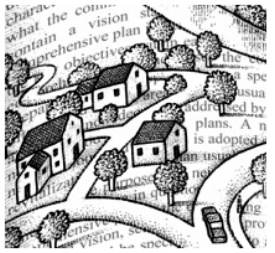Editor’s note: see also my conversation with planner Wendy Grey about her article.
Read an excerpt from this article below. You can download the full article by using the link at the end of the excerpt.
 In this article, we’ll explore the relationship between the comprehensive plan and its implementing regulations and some strategies for improving how these documents work together.
In this article, we’ll explore the relationship between the comprehensive plan and its implementing regulations and some strategies for improving how these documents work together.
We’ll also discuss the local planning process as a “feedback loop” — that is, the need for the plan and regulations to be refined and improved on a regular basis as a result of practical experience and ongoing evaluation.
The Comprehensive Plan
1. Sections of the Plan
As its name implies, the comprehensive plan is the broadest document guiding development. The plan typically contains sections (sometimes called “elements”) that address the major subjects influencing the community’s development. The sections will generally include land use, transportation, environmental resource protection, infrastructure, housing, and economic development. Other sections may include sustainability, historic preservation, community character, and public safety (e.g., disaster preparedness).
Taken together, the sections of the plan should provide a picture of what the community will look like at the end of the selected planning horizon.
Some plans contain a vision statement or pictures that provide a succinct summary of what the comprehensive plan is intending to achieve. The benefit of such an overview is that it shows how the key objectives within each section fit together to achieve the community vision.
2. “Mini” Comprehensive Plans
While the comprehensive plan addresses the community as a whole, some planning departments also prepare plans that apply only to a specific geographic area. These “mini” comprehensive plans (often called “special area” plans) are usually prepared in response to a condition or need within an area that is not adequately addressed by the comprehensive plan.
Consider a city that has recently annexed a large amount of vacant land under single ownership. The city wants to encourage the use of innovative planning techniques such as transit-oriented development, but there are policies throughout the comprehensive plan that impede this. The city does not want to make wholesale changes to the plan since current policies work well for the rest of the city, which is largely built out. In this situation, a more focused mini plan that applies only to the newly annexed area would likely be a good solution.
Similar to special area plans are neighborhood and district plans. A neighborhood plan addresses the needs of a particular neighborhood and typically is adopted either to protect its existing character or promote sensitive revitalization. A district plan usually addresses a commercial area or several neighborhoods and has the same purpose as a neighborhood plan. Since the conditions that the plan addresses are unique to the area in question, it is appropriate to have a set of policies that apply only to it.
3. Providing a Vision for the Community’s Future
The comprehensive plan is the overarching policy document for the community. It should establish a long-term vision, set priorities, and provide direction for how the vision will be achieved. While the plan should be specific enough to accomplish these objectives, it should not be so detailed that it needs frequent amending. If the plan is constantly being revised, it can devalue the perception of the plan as the guide to the long-term development of the community. Let’s take some examples. …
article then continues, and in Part II covers: Translating the Comprehensive Plan Into Implementing Regulations: 1. The Plan as a Policy Document; 2. Consistency Between the Plan and the Implementing Regulations; 3. Going Beyond the Planning Department; and 4. Keeping the Plan’s Overall Objectives in Mind. Part III of the article covers: The Feedback Loop: 1. What Does the Data Show; 2. Evaluating Approved Projects; and 3. Looking at Your Development Review Process.
You must be logged in or a PlannersWeb member to download this PDF.